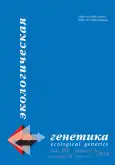Ассоциация уровня общего содержания каротиноидов в зерне кукурузы (Zea mays L.) с аллельным полиморфизмом сайта InDel1 гена PSY1
- Авторы: Орловская О.А.1, Вакула С.И.1, Хотылева Л.В.1, Кильчевский А.В.2
-
Учреждения:
- ГНУ «Институт генетики и цитологии НАН Беларуси»
- НАН Беларуси
- Выпуск: Том 14, № 3 (2016)
- Страницы: 28-34
- Раздел: Статьи
- URL: https://journals.rcsi.science/ecolgenet/article/view/5480
- DOI: https://doi.org/10.17816/ecogen14328-34
- ID: 5480
Цитировать
Полный текст
Аннотация
Кукуруза — единственная из основных зерновых культур, способная накапливать значительное количество каротиноидов, которые являются предшественниками провитамина А. Проведена оценка ассоциации уровня содержания каротиноидов в зерне кукурузы с аллельным полиморфизмом PSY1 InDel1. В работе использовали коллекцию из 54 генотипов кукурузы различного эколого-географического происхождения, методы ПЦР-анализа, спектрофотометрии, статистический анализ. Показано, что в эндосперме генотипов, несущих благоприятный аллель InDel1, содержание каротиноидов в среднем составило 0,60 мг/100 г, что достоверно выше, чем у образцов с неблагоприятным аллелем (0,43 мг/100 г). Таким образом, использование ПЦР-маркеров к полиморфизму PSY1 InDel1 является надежным методом идентификации перспективных генотипов кукурузы с высоким уровнем накопления каротиноидов в зерне.
Ключевые слова
Полный текст
Открыть статью на сайте журналаОб авторах
Ольга Александровна Орловская
ГНУ «Институт генетики и цитологии НАН Беларуси»
Автор, ответственный за переписку.
Email: O.Orlovskaya@igc.by
канд. биол. наук, ведущий научный сотрудник, лаборатория экологической генетики и биотехнологии Россия
Светлана Ивановна Вакула
ГНУ «Институт генетики и цитологии НАН Беларуси»
Email: svettera@yandex.ru
младший научный сотрудник, лаборатория экологической генетики и биотехнологии Россия
Любовь Владимировна Хотылева
ГНУ «Институт генетики и цитологии НАН Беларуси»
Email: L.Khotyleva@igc.by
д-р биол. наук, главный научный сотрудник, лаборатория экологической генетики и биотехнологии Россия
Александр Владимирович Кильчевский
НАН Беларуси
Email: Kilchev@presidium.bas-net.by
д-р биол. наук, главный ученый секретарь НАН Беларуси Россия
Список литературы
- Руководство по методам контроля качества и безопасности биологически активных добавок к пище. — М.: Федеральный центр госсанэпиднадзора Минздрава России, 2004. — 240 с. [Rukovodstvo po metodam kontrolya kachestva i bezopasnosti biologicheski ak tivnykh dobavok k pishche. Moscow: Federal’nyi tsentr gossanepidnadzora Minzdrava Rossii; 2004. P. 240 (In Russ.)]
- de Almelda Rios S, Paes MCD, Cardoso WS, et al. Colour of corn grains and carotenoid profile of importance for human health. American Journal of Plant Science. 2014;5:857-862. doi: 10.4236/aips.2014.56099.
- Azmach G, Gedil M, Menkir F, et al. Marker-trait association analysis of functional gene markers for provitamin A levels across diverse tropical yellow maize inbred lines. BMC Plant Biol. 2013;13(1):227-243. doi: 10.1186/1471–2229–13–227.
- Babu R, Rojas NP, Gao S, et al. Validation of the effects of molecular marker polymorphisms in LcyE and CrtRB1 on provitamin A concentrations for 26 tropical maize populations. Theor Appl Genet. 2013;126(2):389-399. doi: 10.1007/s00122–012–1987–3.
- Fraser PD, Bramley PM. The biosynthesis and nutritional uses of carotenoids. Progress in Lipid Research. 2004;43(3):228-265. doi: 10.1016/j.plipres.2003.10.002.
- Fu Z, Chai Y, Zhou Y, et al. Natural variation in the sequence of PSY1 and frequency of favorable polymorphisms among tropical and temperate maize germplasm. Theor Appl Genet. 2013;126(4):923-935. doi: 10.1007/s00122–012–2026–0.
- Fu ZY, Yan JB, Zheng YP, et al. Nucleotide diversity and molecular evolution of the PSY1 gene in Zea mays compared to some other grass species. Theor Appl Genet. 2010;120:709-720.
- Harjes CE, Rocheford TR, Bai L, et al. Natural Genetic Variation in Lycopene Epsilon Cyclase Tapped for Maize Biofortification. Science. 2008;319(5861):330-333. doi: 10.1126/science. 1150255.
- Krinsky NI, Johnson EJ. Carotenoid actions and their relation to health and disease. Mol Aspects Med. 2005;26(6):459-516. doi: 10.1016/j.mam.2005.10.001.
- Mishra P, Singh NK. Spectrophotometry and TLC based characterization of kernel carotenoids in short duration maize. Maydica. 2010;55:95-100.
- Owens BF, Lipka AE, Magallanes-Lundback M, et al. A foundation for provitamin A biofortification of maize: genome-wide association and genomic prediction models of carotenoid levels. Genetics. 2014;198:1699-1716.
- Safawo T, Senthil N, Raveendran M, et al. Exploitation of natural variability in maize for β-carotene content using HPLC and gene specific markers. Electronic Journal of Plant Breeding. 2010;1(4):548-555.
- Yang XH, Gao SB, Xu ST, et al. Characterization of a global germplasm collection and its potential utilization for analysis of complex quantitative traits in maize. Mol Breeding. 2011;28:511-526.
- Zhu, CF, Naqvi S, Breitenbach J, et al. Combinational genetic transformation generates a library of metabolic phenotypes for the carotenoid pathway in maize. Proceedings of the National Academy of Sciences. 2008;105(47):18232-18237.
Дополнительные файлы






